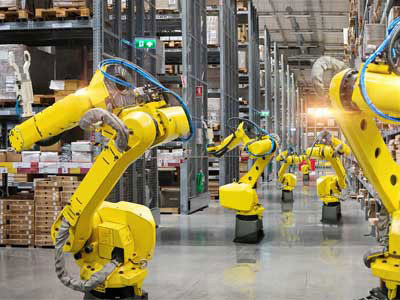Key Takeaway
Robots are essential in the automotive industry. They handle tasks like painting, welding, and assembly with precision. In car manufacturing plants, robots work in almost every area. For instance, painting robots ensure a smooth finish, while welding robots join car parts with accuracy. Assembly robots put together various components, speeding up production. Additionally, robots handle materials, moving parts and tools around the plant efficiently. This automation not only improves quality but also increases production speed and safety, making robots vital in modern car manufacturing.
Automated Assembly
In the automotive industry, robots play a crucial role in automated assembly. They handle repetitive and precise tasks such as assembling engines, installing windshields, and mounting wheels. These robots ensure high-quality consistency and speed, significantly boosting production rates. With their ability to work tirelessly without breaks, robots in assembly lines enhance efficiency and reduce human error. Advanced robotic arms equipped with sensors and cameras perform intricate tasks with precision, ensuring each component is correctly placed and secured, leading to higher overall quality in vehicle production.

Component Manufacturing
Robots have revolutionized the manufacturing of automotive components. They are integral to creating parts such as gears, brake systems, and engine components. These robots ensure each part meets exact specifications, significantly improving the reliability and performance of the final product. Robotic machining and fabrication provide high precision, which is critical in the automotive industry. By handling materials with exactness—from cutting and welding to assembling small parts—robots reduce production time and material waste, while also enhancing safety. This keeps workers away from hazardous processes and ensures the consistent quality of each component.
The automation brought by robots in component manufacturing guarantees that each part is produced to the highest standards, contributing to the overall quality and durability of vehicles. These robots work tirelessly and without error, ensuring that every component meets stringent industry standards. The precise control over machining processes leads to fewer defects and higher efficiency, ultimately resulting in better-performing vehicles. The ability of robots to handle repetitive tasks with unwavering accuracy makes them indispensable in the manufacturing sector, ensuring the production of top-tier automotive components.
Precision Welding
In the automotive industry, precision welding is critical for the structural integrity of vehicles, and robots excel in this domain. Robotic welding systems offer unparalleled accuracy and consistency, essential for creating strong, defect-free welds. These robots can perform various welding techniques, such as spot welding and arc welding, with remarkable precision. Equipped with advanced sensors and control systems, they ensure each weld is strong and reliable. This not only enhances the safety and durability of vehicles but also accelerates the production process.
Robots can operate in high-temperature environments and perform repetitive welding tasks without fatigue, ensuring a continuous and efficient production line. Their ability to maintain consistent quality over long periods is unmatched by human workers. Robotic welders ensure that each vehicle’s frame and body components are welded perfectly, which is crucial for vehicle safety. The integration of robotic welding in the automotive industry has led to significant improvements in production speed, quality, and worker safety, making it an indispensable part of modern manufacturing processes.
Inspection and Testing
Ensuring the quality of each vehicle is paramount in the automotive industry, and robots play a crucial role in inspection and testing. Robotic inspection systems use advanced imaging technologies, such as 3D scanning and X-ray vision, to detect defects and inconsistencies. These robots perform comprehensive checks on assembled vehicles, from alignment and paint quality to electronic systems. Automated testing robots simulate real-world conditions to test the performance and durability of vehicles, ensuring that only the best vehicles reach the market.
By identifying issues early in the production process, these robots help reduce defects and recalls, saving manufacturers significant costs and protecting their reputation. Robotic inspection and testing systems work tirelessly to ensure that every component and system meets stringent quality standards. The precision and thoroughness of these robots surpass human capabilities, providing a higher level of quality assurance. The integration of robots in inspection and testing processes has revolutionized quality control in the automotive industry, ensuring that each vehicle is built to the highest standards.
Logistics and Material Handling
Robots are vital in logistics and material handling within automotive manufacturing plants. Automated Guided Vehicles (AGVs) and robotic forklifts transport parts and materials throughout the factory floor, ensuring a smooth and efficient flow of goods. These robots can navigate complex environments, avoiding obstacles and optimizing delivery routes. By automating material handling, manufacturers reduce the risk of injuries associated with manual lifting and improve overall operational efficiency.
Robots ensure that parts and materials are delivered just-in-time, reducing inventory costs and streamlining the production process. This automation leads to a more organized and efficient workflow, enhancing productivity. The precision and reliability of robotic systems in material handling reduce delays and ensure that production schedules are maintained. The use of robots in logistics and material handling is essential for modern automotive manufacturing, providing a safer and more efficient working environment and ensuring that the production line runs smoothly and without interruptions.
Conclusion
Robots have revolutionized the automotive industry by enhancing efficiency, precision, and safety across various manufacturing processes. From automated assembly and component manufacturing to precision welding, inspection, and logistics, robots play a critical role in ensuring the high quality and consistency of vehicles. As technology continues to advance, the integration of AI and IoT will further enhance the capabilities of robots in automotive manufacturing, driving innovation and productivity in the industry. Embracing robotic automation not only improves production rates but also ensures that manufacturers can meet the growing demands for high-quality vehicles in a competitive market.
